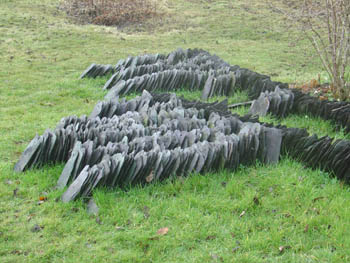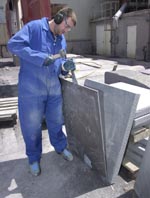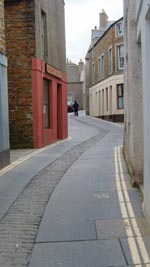|
|
ENGLISH STONE FORUM |
|
.
|
Home
> Issues > Building stone industry in Britain
1
| 2 | 3&4
| 5 |
6 |
7
| 8 | 9
| 10 | 11
|
|
|
6.
A geological survey of Britain's building stone resources
Pre-Cambrian (>540 million years)
|

Swithland slates
|
Of
the Pre-Cambrian outcrops in England the Swithland Slates were quarried
from steeply dipping inliers of Charnian age rocks, from a unit now known
as the Swithland Greywacke Formation. The rocks are true slates, having
a metamorphically induced but quite coarse cleavage. They are hard, very
fine grained, greywacke sandstones and siltstones which split along the
cleavage relatively easily, though often irregularly, into thin slabs.
The Swithland Slates are characteristically purple to green-grey in colour.
They are best seen today in the roofs of the older houses in the villages
of Leicestershire surrounding the quarry sites. Larger slate slabs from
both the Ballachullish and Swithland quarries were also elaborately carved
by local craftsmen for headstones and are commonly found in local village
graveyards in both quarrying areas.
Lower Palaeozoic (540-417 m.y)
|

Splitting roofing slate at Penrhyn
quarry Gwynedd
|
However,
the greatest contribution of the Lower Palaeozoic succession to the stone
industry of Britain has been in the production of roofing slates. The slate
quarries of North Wales have supplied a substantial portion of their purple
and blue-grey roofing slate to much of the country. From relatively small
local beginnings they were able, first by the development of the narrow-gauge
railway systems into the heart of the quarrying areas and later with the
expansion of the national rail network to eclipse most of the other roofing
slate quarry production in the rest of Britain. The famous quarries at
Penrhyn and Llanberis produced purple slates from Cambrian rocks; those
at Blaenau Ffestiniog grey slates from the Ordovician succession and those
at Corwen, grey and green slates from the Silurian rocks. A significant
slate industry also developed in Dyfed in Wales during the 19th century
(Tucker & Tucker 1979; Lott & Barclay 2002).
Elsewhere in Britain slates have been produced commercially from the Ordovician rocks at the Burlington, Tilberthwaite and Honiston quarries in Cumbria (Geddes 1975). These slate quarries were widely renowned long before the boom in Welsh slate production. The heavier 'Westmoreland' green slates were widely used on prestigious buildings throughout the country before being displaced by the thinner and lighter Welsh slates. Several slate quarries are still operational in the area. |
| Of the Cambrian outcrops in England the Swithland Slates were quarried from steeply dipping inliers of Chamian age rocks, from a unit now known as the Swithland Greywacke Formation. The rocks are true slates, having a metamorphically induced cleavage. They are hard, very fine grained, greywacke sandstones and siltstones which split along the cleavage relatively easily, though often irregularly, into thin slabs. The Swithland Slates are characteristically purple to green-grey in colour. They are best seen today in the roofs of the older houses in the villages of Leicestershire surrounding the quarry sites. Larger slate slabs from both the Ballachullish and Swithland quarries were also elaborately carved by local craftsmen for headstones and are commonly found in local village graveyards nearby both quarrying areas. | |
| Upper
Palaeozoic (417-248 m.y.) - Devonian, Carboniferous and Permian systems:
Devonian building stones
The Devonian system includes those rock units commonly known as the Old Red Sandstone. They outcrop extensively in Devon, the Welsh Borders, the Midland Valley and the north east of Scotland and have been quarried for building stone at many localities within each of these areas, in some cases for many centuries, and were widely used in vernacular housing. Some of the stones have a well deserved reputation for durability and are used throughout Britain and were in the past exported widely overseas. |
|
 crop.jpg)
Cornish rag slating St Mabena
|
In South West England the rocks of the Devonian system are best known for two important products. The best known is the silver grey-green to brown roofing slates of the Delabole Quarry. The quarry has been in operation for over 500 years and continues to thrive today. There are many Devonshire villages either roofed with these slates or whose walls are clad in large slates (‘slate-hung’) to provide additional protection for the softer, less durable, local building stones. The Devonian succession has also been an important source of decorative, polished, limestone slabs or marbles' for many decades. Few quarries are, however, operating today. The best known varieties included the pink-veined Ashburton 'Marble', Red Ipplepen, Petitor, Plymouth Black and Red & Grey Ogwell limestones etc (Watson 1916). The hard, variegated - red-orange-yellow-brown and white - limestones from this area, often with complex fabrics and containing spectacular ‘coral’ fossils were used, when highly polished, as decorative 'marble' cladding or for fireplaces. |

Devonian sandstone flagging and sets.
Stromness, Orkney
|
In
Herefordshire and Gwent the local dull red to purple, Devonian sandstones
continue to be widely used for new building and conservation work. One
quarry in particular has a very long history, the 'Red' Wilderness Quarry,
which producess a hard red sandstone most recently seen in a new office
block in Central London at the Poultry. The Wilderness Quarry like several
other famous stone quarries in Britain received considerable attention
from the geological community in Victorian times when spectacular fossils
were discovered during the quarrying operations. Elsewhere numerous small
quarries have worked the sandstones for local building in past centuries
and in Hereford, Ross on Wye and Monmouth the stone is widely displayed
(Hunt 1858). Probably its most famous usage is for the ornately carved
Norman doorway at Kilpeck Church. Locally pale greenish-white sandstone
varieties also occurred and were widely used in local buildings as at Withington.
In Scotland the Devonian succession has yielded abundant sandstone for building particularly in the Dundee area. In the 19th century numerous quarries were known to have worked the reddish sandstones (Mackie 1980). Good access from these quarries to the coastal ports lead to a flourishing market in England, Europe and even North America and Australia for much of the late 18th and 19th centuries. The most successful quarries were probably those at Carmyllie with its fine, bluish-green, sandstone being shipped extensively overseas, notably for paving in Cologne Cathedral (Mackie op. cit.). Further north the thinly bedded Devonian sandstone successions in the well known quarries around Thurso in Caithness have provided paving stone for centuries to many towns and cities in Britain, Europe and America. Omand & Porter (1981) list 43 towns and cities in England alone, which the quarries had supplied with flagstones by 1877. They also show exports from the quarries to Australia, India, New Zealand and even South America. The dark grey to black, fine grained sandstones have been used to constructing vernacuiar buildings for centuries, commercially, however, the flagstone industry developed extensively in the 19th century and has, after a period in the doldrums this century, has now become a flourishing industry once again. |
| 1 | 2 | 3&4 | 5 | 6 | 7 | 8 | 9 | 10 | 11 | |
| . |
|